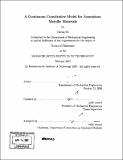| dc.contributor.advisor | Lallit Anand. | en_US |
| dc.contributor.author | Su, Cheng, Ph. D. Massachusetts Institute of Technology | en_US |
| dc.contributor.other | Massachusetts Institute of Technology. Dept. of Mechanical Engineering. | en_US |
| dc.date.accessioned | 2007-09-28T13:10:08Z | |
| dc.date.available | 2007-09-28T13:10:08Z | |
| dc.date.copyright | 2007 | en_US |
| dc.date.issued | 2007 | en_US |
| dc.identifier.uri | http://hdl.handle.net/1721.1/38928 | |
| dc.description | Thesis (Ph. D.)--Massachusetts Institute of Technology, Dept. of Mechanical Engineering, 2007. | en_US |
| dc.description | Includes bibliographical references (leaves 153-161). | en_US |
| dc.description.abstract | A finite-deformation, Coulomb-Mohr type constitutive theory for the elastic-viscoplastic response of pressure-sensitive and plastically-dilatant isotropic materials has been developed. The constitutive model has been implemented in a finite element program, and the numerical capability is used to study the deformation response of amorphous nietallic glasses. Specifically, the response of an amorphous metallic glass in tension, compression, strip-bending, and indentation is studied, and it is shown that results from the numerical simulations qualitatively capture major features of corresponding results from physical experiments available in the literature. The response of a Zr-based glass in instrumented plane strain indentation with a cylindrical indenter tip is also studied experimentally. The constitutive model and simulation capability is used to numerically calculate the indentation load versus depth curves, and the evolution of corresponding shear-band patterns under the in-denter. The numerical simulations are shown to compare very favorably with the corresponding experimental results. The constitutive model is subsequently extended to the high homologous temperature regime, and the response of a representative Pd-based metallic glass in tension at various strain rates and temperatures with different pre-annealing histories is studied. | en_US |
| dc.description.abstract | (cont.) The model is shown to capture the major features of the stress-strain response and free volume evolution of this metallic glass. In particular, the phenomena of stress overshoot and strain softening in monotonic experiments at a given strain rate and temperature, as well as strain rate history effects in experiments involving strain rate increments and decrements are shown to be nicely reproduced by the model. Finally, a cavitation mechanism is incorporated in the constitutive model to simulate the failure phenomenon caused by the principal and hydro-static stresses. With the revised theory, the response of a prototypical amorphous grain-boundary is investigated, and the result is later applied to study the deformation and failure behavior of nanocrystalline fcc metals by coupling with appropriate crystal-plasticity constitutive model to represent the grain interior. | en_US |
| dc.description.statementofresponsibility | by Cheng Su. | en_US |
| dc.format.extent | 161 leaves | en_US |
| dc.language.iso | eng | en_US |
| dc.publisher | Massachusetts Institute of Technology | en_US |
| dc.rights | M.I.T. theses are protected by copyright. They may be viewed from this source for any purpose, but reproduction or distribution in any format is prohibited without written permission. See provided URL for inquiries about permission. | en_US |
| dc.rights.uri | http://dspace.mit.edu/handle/1721.1/7582 | |
| dc.subject | Mechanical Engineering. | en_US |
| dc.title | A continuum constitutive model for amorphous metallic materials | en_US |
| dc.type | Thesis | en_US |
| dc.description.degree | Ph.D. | en_US |
| dc.contributor.department | Massachusetts Institute of Technology. Department of Mechanical Engineering | |
| dc.identifier.oclc | 165238693 | en_US |
